Plextor S2C SSD Review
Why you can trust Tom's Hardware
Performance Testing
Comparison Products
The Plextor S2 Series performed a little better than we expected, so we widened our range of products while keeping our focus on low-cost entry-level products.
The 850 EVO is the mainstream SATA standard. It is the high-performance product in our group, and it's also the most expensive. A run on Samsung's V-NAND products left the 850 EVO with a premium price, at least by today's consumer SSD standards. Another consumer SSD from South Korea is hot on the EVO's heels. The Sk Hynix SL308 impressed us with its combination of good performance and low cost. Dollar for dollar, it is one of the best mainstream SSDs available.
The other consumer TLC-based products in our charts are the entry-level slot fillers. The performance of these products never stood out. Some often sell for high prices due to the name of the companies behind the effort--mainly Intel and Crucial. We're waiting on a performance-increasing firmware update for the SU800, so the Adata SP550 made the chart over the new 3D-enabled Ultimate SU800. The SP550 is still available at a competitive price point. The BX200 is Crucial's true entry-level SSD, but its performance isn't too far from the MX300.
The OCZ Trion 150 and Mushkin Triactor often sell at aggressive price points. The Trion 150 has made our monthly Best SSDs column due to its low price and direct-to-die write technology that increases native TLC sequential write performance.
Sequential Read Performance
To read about our storage tests in-depth, please check out How We Test HDDs And SSDs. We cover four-corner testing on page six of our How We Test guide.


The low-cost products don't deliver a big wow-factor, and we've seen the Samsung 850 EVO 500GB on the charts for a couple of years now. These are utility SSDs at this point. If you already own an SSD, most of the drives in the chart are not worthy successors. Pay close attention if you are coming from a hard disk drive and need an aftermarket replacement--you are the target customer.
The sequential read test is the easiest of the four-corner tests. Nearly all the products deliver over 500 MB/s and provide consistent performance.
Get Tom's Hardware's best news and in-depth reviews, straight to your inbox.
Sequential Write Performance


At first, the Plextor S2C's low sequential write performance perplexed us, but we quickly realized the problem. The Plextor S2 suffers from the same sequential write issues as many products with TLC NAND flash and an SMI controller (such as the Intel 600p). Many of the other SSD controller manufacturers have abandoned folding data from the SLC cache to TLC flash after the cache is full and instead moved to direct-to-die writes. Direct-to-die writes take place at over twice the speed, but it wears the flash faster.
Sustained Sequential Write
The sustained sequential write test with 128KB blocks across the entire LBA range reveals a distinctive pattern. We ran the test again, and the pattern became even more erratic. The portions of the test that measured ~200 MB/s disappeared, and we measured more peaks and valleys ranging between 65 to 190 MB/s.
Random Read Performance



Random read performance separates the Samsung 850 EVO and Sk Hynix SL308 from the rest of the low-cost SATA SSDs. The Plextor S2C 512GB outperforms most of the other products at low queue depths, but it doesn't quite make it into the upper tier as workload intensity increases.
Random Write Performance



The Plextor S2C 512GB made up for the average random read performance with a strong random write showing at low queue depths. The drive ran into a wall at queue depth 4 and stopped scaling. Many of the other products have the same scaling issue, but still offer much higher performance than you will find with a hard disk drive.
80 Percent Sequential Mixed Workload
We describe our mixed workload testing in detail here and describe our steady state tests here.
The sequential mixed workload test with the low-cost products looks like exotic wall art. All of these products rely on an SLC cache to improve performance, so any sustained workload with a small dose of write data hurts the user experience.
80 Percent Random Mixed Workload
The random mixed workload test is a little more refined with predictable performance. The 850 EVO stands out from the rest of the products, which all perform about the same with only slight variation. SSDs with SLC cache are inconsistent by nature, and those without direct-to-die writes are even more inconsistent.
Sequential Steady-State
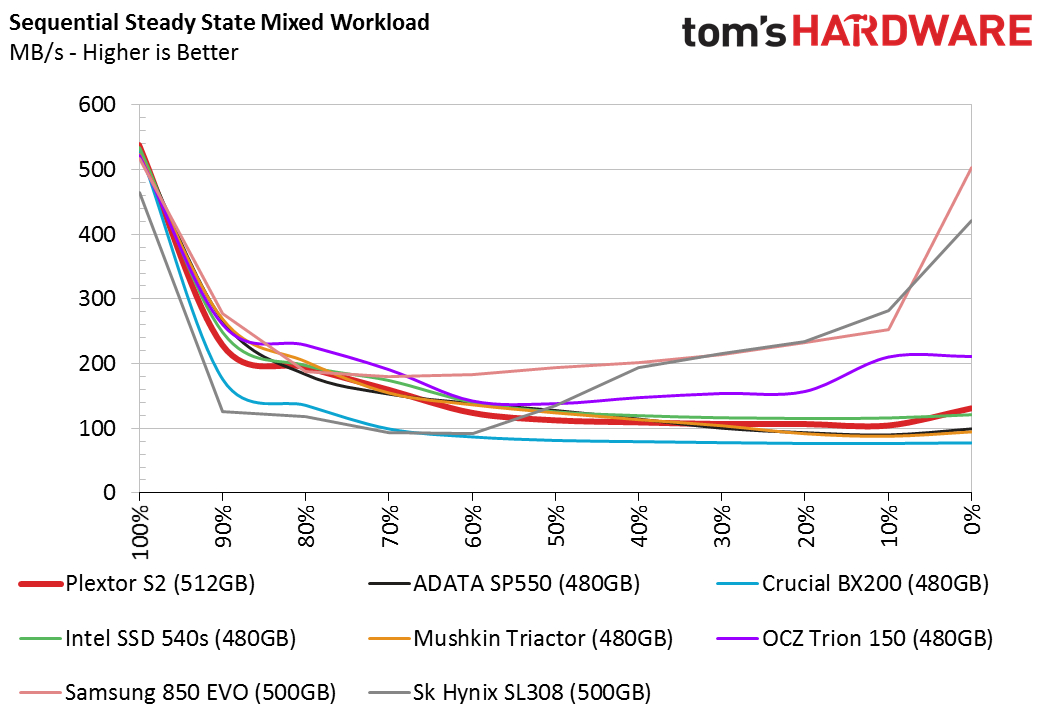

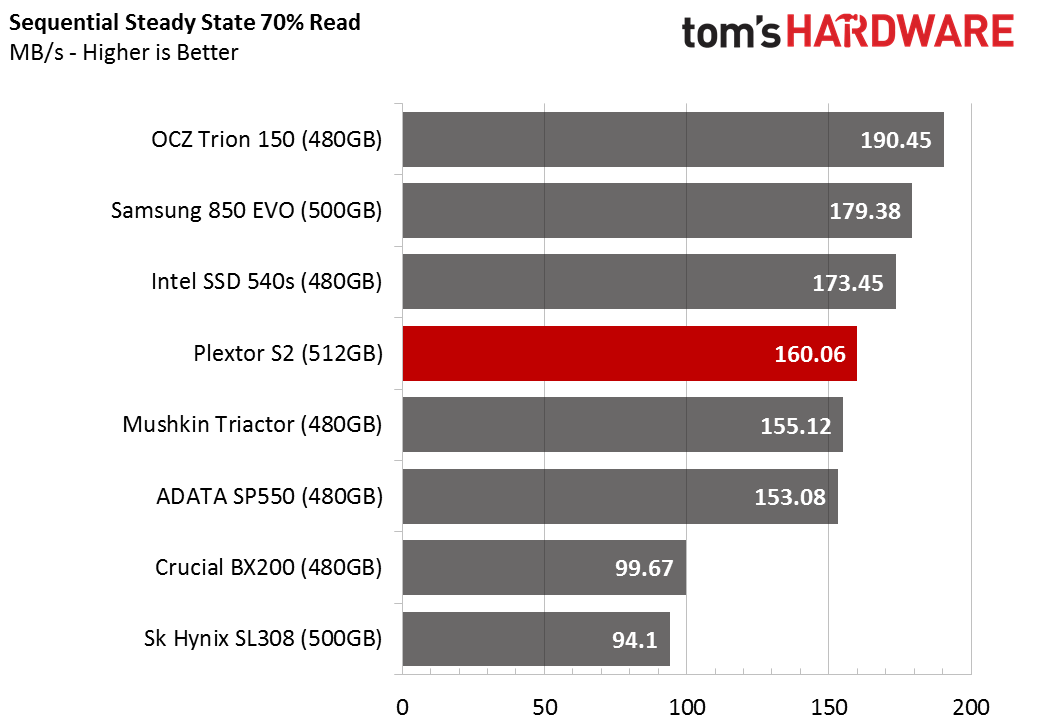
None of these products will work well in professional applications with heavy data write traffic. The low endurance rating will keep professional users from tackling demanding tasks repeatedly.
Random Steady-State


The Plextor S2C 512GB delivers more consistent performance than we expected. The only problem is the low performance rate. The first product in the Plextor S2 series isn't a good candidate for a consumer RAID array hanging off the Intel chipset.
PCMark 8 Real-World Software Performance
For details on our real-world software performance testing, please click here.







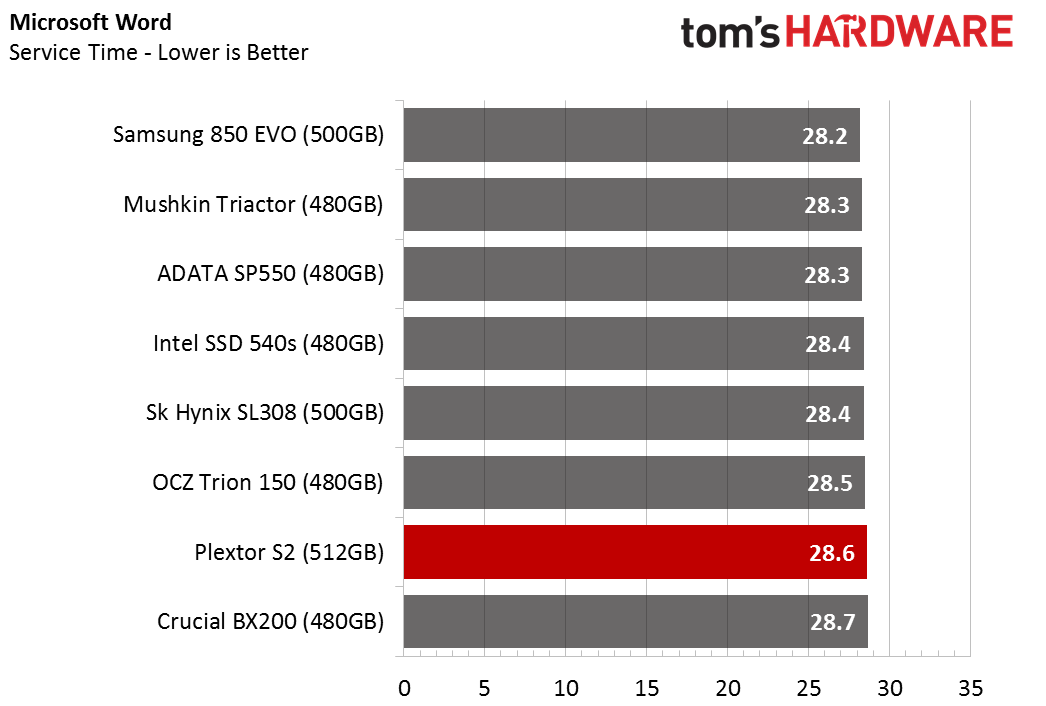

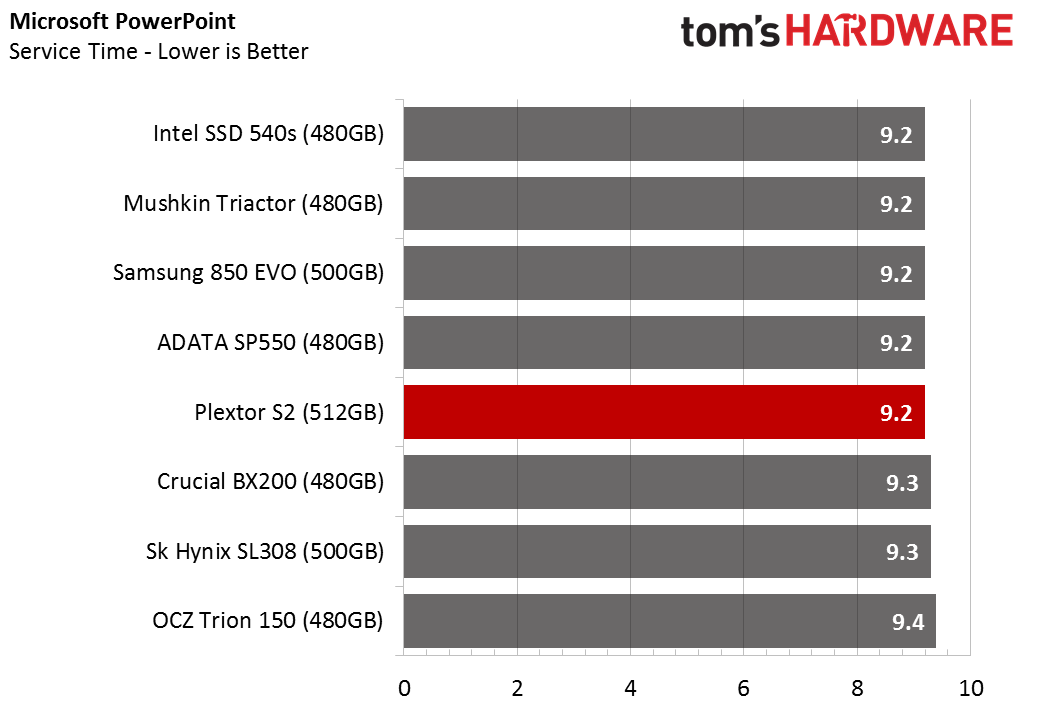
Applications with bursty workloads that stay within the SLC cache perform well with the Plextor S2C 512GB. Performance drops off quite a bit when the workload moves outside of the SLC cache, so the drive falls behind products with direct-to-die writes. For most of us, the typical workload will fit into the narrow band of SLC cache.
Application Storage Bandwidth
We average the results together and present them as throughput to get a better understanding of the S2C. We can declare the drive is average, so there really isn't a lot to get excited about. It's a low-cost SSD with better-than-disk performance, but it's not as cool as a professional model or new NVMe SSD.
PCMark 8 Advanced Workload Performance
To learn how we test advanced workload performance, please click here.



The light workload test shows the Plextor S2C in the pack of other similar low-cost consumer SSDs. The results also show why the Samsung 850 EVO commands a price premium over the other SSDs in the test.
Total Service Time



The service time results tell a similar story. The Plextor S2C 512GB is just in the mix, but it doesn't show anything outstanding that would lead us to pay more for this product over several others available.
Disk Busy Time
In recent years, Plextor had some issues with latency and disk busy time. Plextor released a firmware update for the M8Pe we tested two months ago to correct the issue, but the company was never able to fix the issue with many of the M6 products. The S2C doesn't have the issue, so it appears Plextor (maybe with the help of SMI) reigned in those issues and got back on track.
Notebook Battery Life
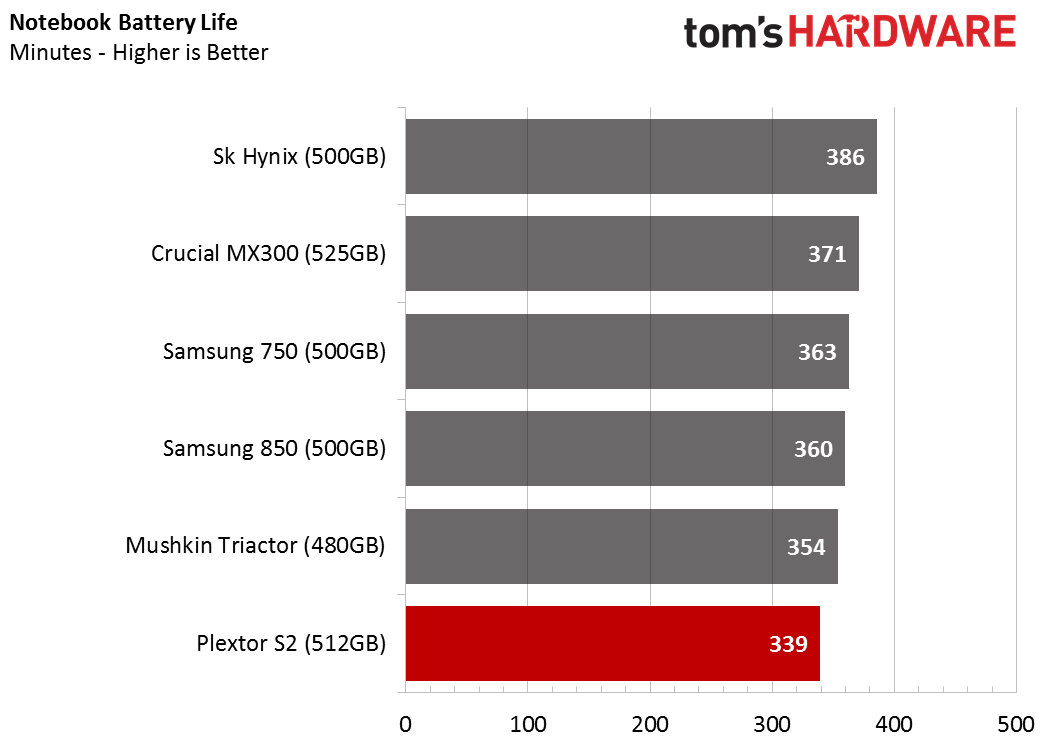

The Plextor S2C 512GB doesn't hold up well when it is on notebook battery power. The drive scores a low time measurement while the system operates under battery power during the MobileMark 2014.5 Office Test. The actual performance is also well off from some of the other drives we include in this test.

Chris Ramseyer was a senior contributing editor for Tom's Hardware. He tested and reviewed consumer storage.
-
wtfiwin @skoalreaver relax probably just meant what it says.Reply
can't wait to see some QLC or 3D-QLC for mass storage 20TB SSDs. -
Medric it is a pro cause its here but a con because this will start to be standerd; no more 8 channel so you know this could go alot faster than it is but i wont so it sucksReply -
chumly @ChrisReply
I never buy anything except for Samsung SSDs (unequaled performance numbers). However I run them in RAID. I was curious if RAID performance, especially in the real world application (game loads), would take less time or more time. I have never seen a comparison done in the kinds of tests you guys do with storage performance in tandem. I'm curious if it's worth the average person's time to run paired discs vs. unpaired. -
CRamseyer It is a pro and a con. As mentioned above, it is a good thing because we will get lower prices but a con because this type of performance is now the norm. It really all depends on when you jumped on the SSD train. I've been riding along since 2007 and saw performance rise, continue to rise for several years and then suddenly use "tricks" to achieve high levels of performance.Reply
If you only recently used SSDs then the least common denominator method is normal and acceptable.
If your workload requires or uses heavy sequential reads and writes then RAID for performance (RAID 0) is a powerful tool with SATA SSDs. NVMe products are generally fast enough where RAID doesn't deliver the same performance increase. The bottleneck moves away from the storage device and to other areas like the file system. -
HERETIC-1 Hi Chris,Reply
Nice review as always.Wouldn't surprise me if Plextor/Liteon wasn't the OEM
for the Intel 540.
One change I'd have made was-Drop the Crucial lemon from the charts,and
added 750 EVO........................ -
CRamseyer Pricing for the 750 EVO is so hit or miss these days in relation to the 850 EVO. If Samsung could keep it a good 20-25% less we would take it more serious. The difference in the 250GB capacity size right now on Amazon is less than $10. Unless you are digging through the couch to fund the purchase the easy pick between the two is the 850 EVO.Reply -
daglesj 32GB of ram to use the Turbo Feature? Someone didn't bother optimising their software.Reply -
daglesj I'd be intrigued to find out how the old budget fave the Kingston V300 fares against these TLC parts.Reply -
CRamseyer Which version of the V300? I don't know how many exist now but it's a handful of different controller and NAND configurations.Reply
I'm working on a page that will have tests from a bunch of SSDs in very long, organized, charts.







